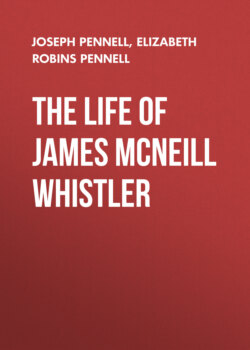Читать книгу The Life of James McNeill Whistler - Joseph Pennell - Страница 35
На сайте Литреса книга снята с продажи.
THE FORGE
ОглавлениеTable of Contents
DRY-POINT. G. 68
(See page 67)
The chief bond between Whistler and Rossetti was their love for blue and white and Japanese prints. Whistler was in Paris in 1856, when Bracquemond "discovered" Japan in a little volume of Hokusai used for packing china, and rescued by Delâtre, the printer. It passed into the hands of Laveille, the engraver, and from him Bracquemond obtained it. After that, Bracquemond had the book always by him; and when in 1862 Madame Desoye, who, with her husband, had lived in Japan, opened a shop under the arcades of the Rue de Rivoli, the enthusiasm spread to Manet, Fantin, Tissot, Jacquemart and Solon, Baudelaire and the De Goncourts. Rossetti was supposed to have made it the fashion. But the fashion in Paris began before Rossetti owned his first blue pot or his first colour-print. Whistler brought the knowledge and the love of the art to London. "It was he who invented blue and white in London," Mr. Murray Marks assured us, and Mr. W. M. Rossetti was as certain that his brother was inspired by Whistler, who bought not only blue and white, but sketch-books, colour-prints, lacquers, kakemonos, embroideries, screens. "In his house in Chelsea, facing Battersea Bridge," Mr. Severn writes, "he had lovely blue and white, Chinese and Japanese." The only decorations, except the harmony of colour, were the prints on the walls, a flight of Japanese fans in one place, in another shelves of blue and white. People, copying him, stuck up fans anywhere, and hung plates from wires. Whistler's fans were arranged for colour and line. His decorations bewildered people even more than the work of the new firm of Morris, Marshall, Faulkner and Co. The Victorian artist covered his walls with tapestry, filled his studio with costly things, and made the public measure beauty by price, a fact overlooked by Whistler, but never by Morris.
Rossetti joined in the hunt for blue and white. Henry Treffy Dunn, in his Recollections of Rossetti, whose assistant he was, writes that Rossetti and Whistler "each tried to outwit the other in picking up the choicest pieces of blue to be met with"; that both were for ever hunting for "Long Elizas," a name in which Mr. W. M. Rossetti thought "possibly a witticism of Whistler's may be detected." Howell rushed in and met with the most astounding experiences and adventures. A little shop in the Strand was one of their favourite haunts, another was near London Bridge where a Japanese print was given away with a pound of tea. Farmer and Rogers had an Oriental warehouse in Regent Street. The manager, Mr. Lazenby Liberty, afterwards opened one on the other side of the street, and here, too, Whistler went, introduced to Mr. Liberty by Rossetti. Mr. Liberty rendered him many a service, and visited him to the last. Mr. Murray Marks imported blue and white, and he has told us how the fever spread from Whistler and Rossetti to the ever-anxious collector. Rossetti asked Mr. Marks if he knew anything about blue and white. Mr. Marks said yes; he could get Rossetti a shipload if he chose. Mr. Marks often ran over to Holland, where blue and white was common and cheap, and he picked up a lot, offering it to Rossetti for fifty pounds. Rossetti happened to be hard up and could not afford it. But he came with Mr. Huth, who bought as much as Rossetti could not take, and the rage for it began in England, Sir Henry Thompson, among others, commencing to collect. The rivalry between Whistler and Rossetti lasted for several years, until Rossetti, ill and broken, hardly saw his friends, and until Mr. Marks, in the early seventies, bought back from Whistler and Rossetti all he had sold them.
